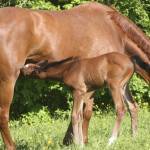Weather Affects Growth Rate of Foals

Can temperature and rainfall affect growth rate of foals? According to researchers in Kentucky, the answer is yes.
Foals born in Kentucky in late winter and early spring begin to graze when pasture quality and palatability are at their highest. One of the biggest factors affecting pasture quality and availability is rainfall and temperature. Researchers at the University of Kentucky studied how pasture-growing conditions affected growth rate in three- and four-month-old foals.
Three hundred twenty-two Thoroughbred foals were periodically weighed from the time of birth to weaning at the same Central Kentucky Thoroughbred farm over a five-year period. Average daily gain (ADG) was calculated for all foals that were three or four months of age in May, June, July, or August of each year. During these months, mare-foal pairs were maintained on large pastures, providing more than four acres per pair. Cool-season grasses and clover were the primary forages in the pastures. Though foals were not creep fed, they had access to their dams’ concentrate meals twice daily. Rainfall information for the region was obtained from the University of Kentucky Ag Center Weather and Climatological Database.
In this study, ADG of three- and four-month-old foals was affected by pasture growing conditions. There was a positive relationship between ADG and rainfall for both three- and four-month-old foals in each month studied. The strongest relationships between ADG and rainfall were found for three-month-old foals in May and August. It was not determined whether the differences in growth were due to pasture consumption by foals directly or by increased milk production of the mares.
This study was presented at the 2011 Equine Science Society Symposium in Murfreesboro, Tenn. The proceedings from this symposium are available from the Journal of Equine Veterinary Science.








